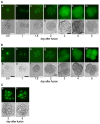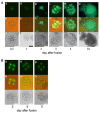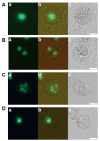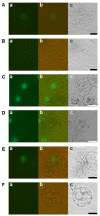The Feeder Effects of Cultured Rice Cells on the Early Development of Rice Zygotes
- PMID: 38003730
- PMCID: PMC10672051
- DOI: 10.3390/ijms242216541
The Feeder Effects of Cultured Rice Cells on the Early Development of Rice Zygotes
Abstract
Feeder cells and the synthetic auxin 2,4-dichlorophenoxyacetic acid (2,4-D) in a culture medium promote mitosis and cell division in cultured cells. These are also added to nutrient medium for the cultivation of highly active in mitosis and dividing zygotes, produced in vitro or isolated from pollinated ovaries. In the study, an in vitro fertilization (IVF) system was used to study the precise effects of feeder cells and 2,4-D on the growth and development of rice (Oryza sativa L.) zygote. The elimination of 2,4-D from the culture medium did not affect the early developmental profiles of the zygotes, but decreased the division rates of multicellular embryos. The omission of feeder cells resulted in defective karyogamy, fusion between male and female nuclei, and the subsequent first division of the cultured zygotes. The culture of zygotes in a conditioned medium corrected developmental disorders. Proteome analyses of the conditioned medium revealed the presence of abundant hydrolases possibly released from the feeder cells. Exogenously applied α-amylase ameliorated karyogamy and promoted zygote development. It is suggested that hydrolytic enzymes, including α-amylase, released from feeder cells may be involved in the progression of zygotic development.
Keywords: 2,4-D; amylase; cell wall; feeder cell; fertilization; hydrolytic enzyme; rice; zygote; zygotic development.
Conflict of interest statement
The authors declare no conflict of interest.
Figures





Similar articles
-
Sperm Entry into the Egg Cell Induces the Progression of Karyogamy in Rice Zygotes.Plant Cell Physiol. 2019 Aug 1;60(8):1656-1665. doi: 10.1093/pcp/pcz077. Plant Cell Physiol. 2019. PMID: 31076767
-
Development of Polyspermic Rice Zygotes.Plant Physiol. 2016 May;171(1):206-14. doi: 10.1104/pp.15.01953. Epub 2016 Mar 4. Plant Physiol. 2016. PMID: 26945052 Free PMC article.
-
Establishment of an in vitro fertilization system in rice (Oryza sativa L.).Planta. 2007 Aug;226(3):581-9. doi: 10.1007/s00425-007-0506-2. Epub 2007 Mar 15. Planta. 2007. PMID: 17361458
-
Development of polyspermic zygote and possible contribution of polyspermy to polyploid formation in angiosperms.J Plant Res. 2017 May;130(3):485-490. doi: 10.1007/s10265-017-0913-9. Epub 2017 Mar 8. J Plant Res. 2017. PMID: 28275885 Review.
-
Polyspermy in angiosperms: Its contribution to polyploid formation and speciation.Mol Reprod Dev. 2020 Mar;87(3):374-379. doi: 10.1002/mrd.23295. Epub 2019 Nov 17. Mol Reprod Dev. 2020. PMID: 31736192 Review.
Cited by
-
Special Issue "State-of-the-Art Molecular Plant Sciences in Japan".Int J Mol Sci. 2024 Feb 17;25(4):2365. doi: 10.3390/ijms25042365. Int J Mol Sci. 2024. PMID: 38397042 Free PMC article.
-
Different neutrophil extracellular trap related Ewing sarcoma subtypes exhibit distinct prognosis, and immune microenvironment characteristics.Sci Rep. 2025 Jul 8;15(1):24523. doi: 10.1038/s41598-025-10277-7. Sci Rep. 2025. PMID: 40628996 Free PMC article.
References
-
- Pritchard H.N. A cytochemical study of embryo development in Stellaria medis. Botany. 1964;51:472–479. doi: 10.1002/j.1537-2197.1964.tb06658.x. - DOI
-
- Schulz R., Jensen W.A. Capsella embryogenesis: The egg, zygote, and young embryo. Am. J. Bot. 1968;55:807–819. doi: 10.1002/j.1537-2197.1968.tb07438.x. - DOI
-
- Schel J.H.N., Kieft H., van Lammeren A.A.M. Interactions between embryo and endosperm during early developmental stage of maize caryopses (Zea mays) Can. J. Bot. 1984;62:2842–2853. doi: 10.1139/b84-379. - DOI
-
- Lindsey K., Topping J.E. Embryogenesis: A question of pattern. J. Exp. Bot. 1993;259:359–374. doi: 10.1093/jxb/44.2.359. - DOI
MeSH terms
Substances
Grants and funding
- Grant No. 22H02315/Japan Society for the Promotion of Science
- Moonshot Program No. 22101490-0/New Energy and Industrial Technology Development Organization
- JST-Mirai Program No. 23-231038606/Japan Science and Technology Agency
- No. 04B2020/Joint Research Program of Arid Land Research Center, Tottori University
LinkOut - more resources
Full Text Sources
Research Materials

